RoundFlash is an innovative lighting accessory that makes your regular flash gun work as a ring light. There is already a number of ring flash adapters on the market today, but RoundFlash differs from them in many ways including size, design concept, and more.
Unlike many other ring flash adapters, RoundFlash is a collapsible modifier. Its design, in a way, resembles the design of collapsible reflectors that you twist to fold and release to let it pop open. Instead of one spring, however, RoundFlash has two of them that, when popped open, form the front and the back walls of the diffuser (sort of a drum with a whole in the middle). To keep the front and the back of the unit parallel, you insert six short carbon-fiber rods into the dedicated holes along the edges, which takes just a few seconds.
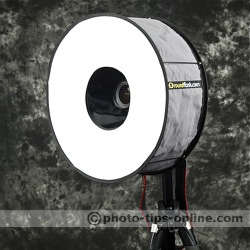 |
 |
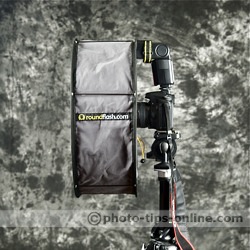 |
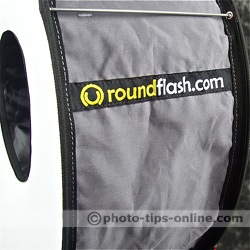 |
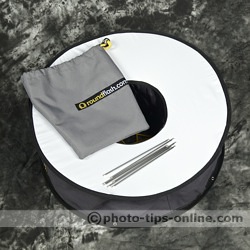 |
 |
Attaching to a camera is quite simple, as well. You just stick your camera's lens into the center hole and tighten the rope, if necessary, as shown in the image below. The rope is stretchy, so it creates tension that keeps RoundFlash in place. If you use lenses of similar diameter, you only need to adjust the rope once.
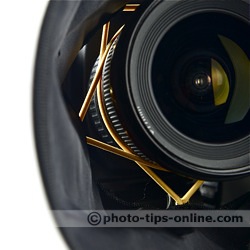 |
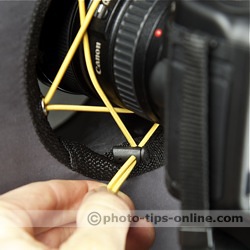 |
Next, you insert your flash gun into the opening at the top and secure it with the built-in strap. The whole procedure takes only and minute or two, and you are ready to shoot.
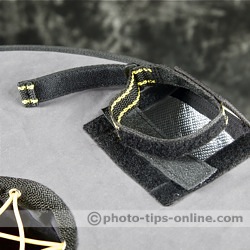 |
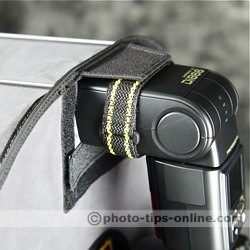 |
With its universal attachment system, RoundFlash ring flash adapter fits a wide range of cameras and flashes. The center hole is large and should be compatible with any lens that can be handheld. The top opening is fairly large too, so you can use flashes of different heights. To reduce the light spill, RoundFlash comes with a Velcro strip that you can use to block the light spilling from the opening.
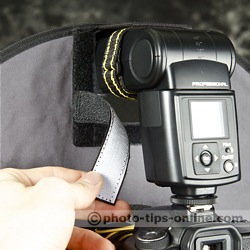 |
RoundFlash weighs only about half a pound (224 grams). We found that it is so lightweight, that you almost don't feel it on your camera especially if you're using a heavier camera body and lens. The attachment feels secure, and unit does not really put any stress on the flash head. We would say that there is virtually no chance that this diffuser can damage your flash or camera even if you start waving the whole rig in the air.
Also, being made of light and soft materials, RoundFlash is unlikely to get damaged when accidently dropped or knocked around.
Another important aspect of any ring flash adapter is how evenly the light is distributed across the ring. The internal reflectors and baffles of RoundFlash are quite clever designed, and they do impressive job of spreading the light evenly regardless of flash zoom settings. Depending on the flash you use, the light loss may vary with the flash zoom value. With Canon Speedlite 580EX II, we saw little variance in light output between 24mm and 105mm, while with Nissin Di866 II set to 105mm, the power was down(surprisingly) by almost 2 f-stops. So, after a number of tests, we recommend setting your flash zoom to 24mm for the best results (this also matches the manufacturer's recommendation). The image below is taken with Speedlite 580EX II set to 24mm zoom to demonstrate how the front diffuser is lit.
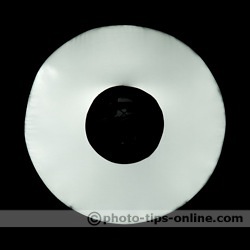 |
Compared to other ring flash adapters (like, for example, RayFlash or Orbis), RoundFlash is huge. It produces softer light and, therefore, the contour shadow typical for ring flash photos is not very distinct. The lighting effect created by RoundFlash is about half-way between the harshness of a typical ring light and almost completely shadowless look delivered by large modifiers like AlienBees Moon Unit. The image below is an example of RoundFlash being used as the only light source.
 |
Evenly lit front surface and large size come at the cost of reduced light output. RoundFlash cannot even approach the light efficiency of RayFlash. It is closer to the Orbis adapter in that regard (see Orbis vs. RayFlash comparison). However, setting your camera to ISO 400 yields pretty good results. You can even use it outdoors as a fill light, as show in the image below.
 |
For real macro work, RoundFlash is too big and bulky, but for some close-ups, it can be pretty handy. And, of course, it's always fun to play with donut-shaped catchlights :).
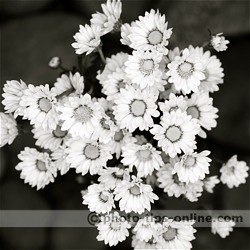 |
 |
Please note that similar to RayFlash, RoundFlash blocks the auto-focus assist beam, so you may run into difficulties trying to focus in dim light conditions. Also, access to some of your lens controls can be more difficult when RoundFlash diffuser is installed, but they still should be accessible as shown in the image below (the actual usability varies depending on the lens design).
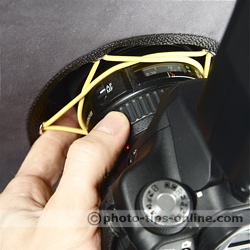 |
Additionally, we want to point out that RoundFlash comes with one spare rod (seven in total). We also found that you can lose up to three rods (including the spare one) and still be able to use the diffuser. Even with only four rods in place, the unit is still functional. So, in case, if you're unfortunate to lose a rod or two, you can keep using RoundFlash while waiting for the replacement to arrive.
The manufacturer recommends using +1.5-stop flash exposure compensation when using RoundFlash diffuser. We did not find it necessary in many cases (especially for close-up shots). In fact, a few times, we had to compensate the flash output into the opposite direction. In general, since RoundFlash is a light modifier and it does not emit light by itself, it's up to TTL system to decide on the proper light output. We didn't feel that TTL had more misses with RoundFlash installed than without it.
The two images below were taken for size comparison of RayFlash and RoundFlash (assembled and collapsed). You can see that being much larger in use, RoundFlash is equally (if not more) portable when folded.
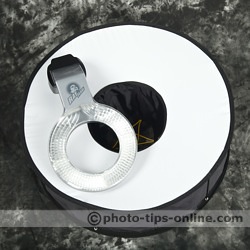 |
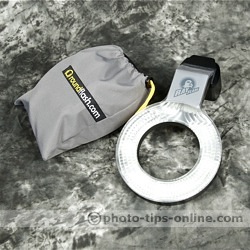 |
RoundFlash ring flash adapter is 17 inches (44cm) in diameter. It is even slightly bigger than Honl Photo traveller16 softbox. As such a large light source, RoundFlash can be also used as an off-camera softbox (especially when handheld; using it on a light stand can be too cumbersome). Even though RoundFlash is not designed to be used this way, we still like having the option of taking it off the camera.
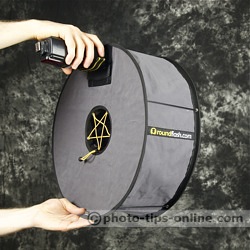 |
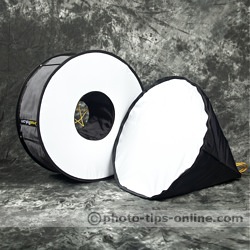 |
We also like the choice of materials RoundFlash creators went with. The unit is well-built and should be able to withstand normal wear and tear without any major problems. The only concern we have is whether the rods will eventually penetrate the material inside the holes or not. This kind of failure, however, should be repairable.
To conclude, RoundFlash ring flash adapter is an exciting lighting accessory for your flash. It is smartly designed and well-implemented. It delivers the unique look of a ring light but produces softer shadows. At the current price point of $139, it's affordable not only for professionals but also for photography enthusiasts. (Available from roundflash.com)